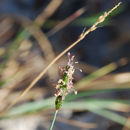Associations
provided by BioImages, the virtual fieldguide, UK
In Great Britain and/or Ireland:
Foodplant / parasite
Blumeria graminis parasitises live Alopecurus geniculatus
Foodplant / pathogen
pycnidium of Dilophospora coelomycetous anamorph of Lidophia graminis infects and damages live inflorescence of Alopecurus geniculatus
Remarks: season: 5-10, esp. 7
Foodplant / spot causer
colony of Mastigosporium anamorph of Mastigosporium album causes spots on leaf of Alopecurus geniculatus
Foodplant / saprobe
colony of Cercosporidium dematiaceous anamorph of Mycosphaerella recutita is saprobic on dead sheath of Alopecurus geniculatus
Foodplant / saprobe
numerous, black pycnidium of Septoria coelomycetous anamorph of Septoria alopecuri is saprobic on dead culm of Alopecurus geniculatus
Remarks: season: 7
Comprehensive Description
provided by North American Flora
Alopecurus geniculatus hSp. PI. 60. 1753
Tozzeltia geniculate. Bubani, Fl. Pyren. 4: 275. 1901. (Based on Alopecurus geniculatus L.)
Perennial; culms several-noded, decumbent or long-decumbent at base, rooting at the lower nodes, glabrous, 10-50 cm. long above the rooting base; sheaths glabrous, usually not inflated; ligule 2-3 mm. long; blades scaberulous, 1-4 mm. wide; panicles about as in .1. aequalis; spikelets about 2.5 mm. long, the tip dark-purple ; awn of lemma about as long again as the spikelet; anthers about 1.5 mm. long. Differing from A. aequalis in the longer rooting base, the purple-tipped spikelets, and the more conspicuous awn, giving the panicle a softly bristly appearance.
Type locality: Europe.
Distribution: In water and wet places, Newfoundland to Saskatchewan and British Columbia, and southward through New England to New York, New Jersey, and Virginia, and through Washington to California; Montana; Colorado; Arizona; also in Eurasia.
- bibliographic citation
- Albert Spear Hitchcock. 1937. (POALES); POACEAE (pars). North American flora. vol 17(7). New York Botanical Garden, New York, NY
Comprehensive Description
provided by North American Flora
Alopecurus pallescens Piper; Piper & Beattie, Fl. Palouse Reg. 18. 1901.
Perennial, tufted, pale-green; culms erect or the lower nodes geniculate, glabrous, 30-50 cm. tall; sheaths glabrous, the upper somewhat inflated; ligule thin, acuminate, as much as 7 mm. long; blades flat, scabrous on the upper surface, 1-5 mm. wide; panicles finally longexserted, pale, 2-7 cm. long, 4—6 mm. wide; glumes about 3 mm. long, ciliate on the keel, appressed-pubescent on the sides; lemma about as long as the glumes, glabrous, the awn attached near the base, geniculate, exserted 3-5 mm.; anthers orange, 2 mm. long.
Type locality: Pullman. Washington {Piper 1743).
Distribution: Edges of ponds and wet places, Idaho to Washington and northern California.
- bibliographic citation
- Albert Spear Hitchcock. 1937. (POALES); POACEAE (pars). North American flora. vol 17(7). New York Botanical Garden, New York, NY
Physical Description
provided by USDA PLANTS text
Perennials, Terrestrial, not aquatic, Stems nodes swollen or brittle, Stems erect or ascending, Stems geniculate, decumbent, or lax, sometimes rooting at nodes, Stems caespitose, tufted, or clustered, Stems terete, round in cross section, or polygonal, Stem internodes hollow, Stems with inflorescence less than 1 m tall, Stems, culms, or scapes exceeding basal leaves, Leaves mostly cauline, Leaves conspicuously 2-ranked, distichous, Leaves sheathing at base, Leaf sheath m ostly open, or loose, Leaf sheath smooth, glabrous, Leaf sheath and blade differentiated, Leaf blades linear, Leaf blades 2-10 mm wide, Leaf blades mostly flat, Leaf blades mostly glabrous, Ligule present, Ligule an unfringed eciliate membrane, Inflorescence terminal, Inflorescence a dense slender spike-like panicle or raceme, branches contracted, Inflorescence solitary, with 1 spike, fascicle, glomerule, head, or cluster per stem or culm, Inflorescence spike linear or cylindric, several times longer than wide, Inflorescence single raceme, fascicle or spike, Flowers bisexual, Spikelets pedicellate, Spikelets laterally compressed, Spikelet less than 3 mm wide, Spikelets with 1 fertile floret, Spikelets solitary at rachis nodes, Spikelets all alike and fertille, Spikelets bisexual, Spikelets disarticulating below the glumes, Rachilla or pedicel glabrous, Glumes present, empty bracts, Glumes 2 clearly present, Glumes equal or subequal, Glumes equal to or longer than adjacent lemma, Glume margins connate at base, Glumes keeled or winged, Glumes 3 nerved, Lemmas thin, chartaceous, hyaline, cartilaginous, or membranous, Lemma margins connate below, Lemma 5-7 nerved, Lemma glabrous, Lemma body or surface hairy, Lemma apex truncate, rounded, or obtuse, Lemma distinctly awned, more than 2-3 mm, Lemma with 1 awn, Lemma awn less than 1 cm long, Lemma awn 1-2 cm long, Lemma awn subapical or dorsal, Lemma awn once geniculate, bent once, Lemma margins thin, lying flat, Lemma straight, Stamens 3, Styles 1, Styles 2-fid, deeply 2-branched, Stigmas 2, Fruit - caryopsis, Caryopsis ellipsoid, longitudinally grooved, hilum long-linear.
Alopecurus geniculatus: Brief Summary
provided by wikipedia EN
Alopecurus geniculatus is a species of grass known by the common name water foxtail or marsh foxtail. It is native to much of Eurasia and introduced into North America, South America, and Australia. It grows in moist areas.
Alopecurus geniculatus is a perennial grass forming bunches of erect stems up to about 60 cm (24 inches) in height. The leaves are up 12 cm (5 inches) in length. The pale green to purplish inflorescence is a dense panicle up to 6 or 7 cm long which blooms in dusty yellow-orange anthers. reproduces sexually by seeds and can reproduce vegetatively by rooting at stem nodes.
- license
- cc-by-sa-3.0
- copyright
- Wikipedia authors and editors

